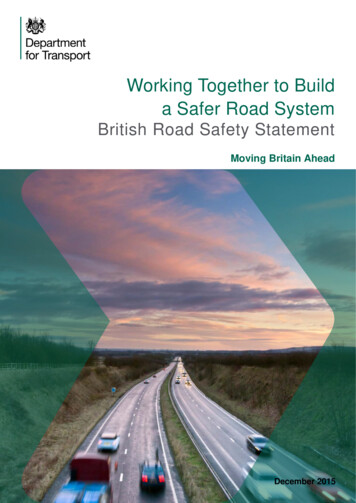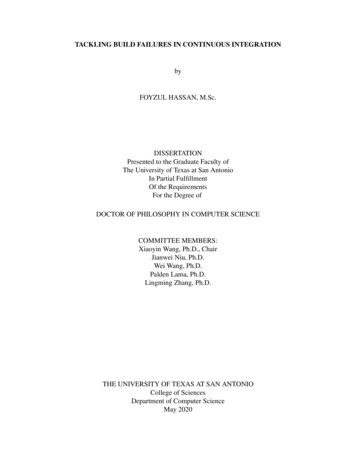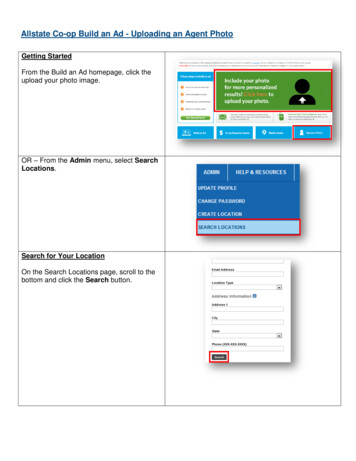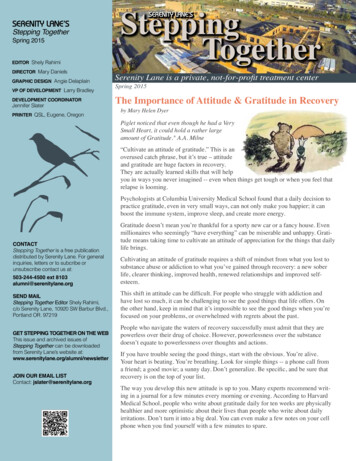
Transcription
Working Together to Builda Safer Road SystemBritish Road Safety StatementMoving Britain AheadDecember 2015
Working Together to Build aSafer Road SystemBritish Road SafetyStatementPresented to Parliamentby the Secretary of State for Transportby Command of Her MajestyDecember 2015Cm 9175
Crown copyright 2015This publication is licensed under the terms of the Open Government Licencev3.0 except where otherwise stated. To view this licence,visit e/version/3 or writeto the Information Policy Team, The National Archives, Kew, London TW94DU, or email: psi@nationalarchives.gsi.gov.uk.Where we have identified any third party copyright information you will need toobtain permission from the copyright holders concerned.This publication is available at www.gov.uk/government/publicationsPrint ISBN 9781474126335Web ISBN 9781474126342ID 277505212/15Printed on paper containing 75% recycled fibre content minimumPrinted in the UK by the Williams Lea Group on behalf of the Controller of HerMajesty’s Stationery Office
ContentsForeword4Executive summary61. British Road Safety in Context9Our road safety record9Road user groups10Embracing devolution: moving beyond top-down targets11Reducing casualties by supporting positive choices12Harnessing technological innovation: future proofing our safer road system12Responding to shifting demographics13Safe systems approach142. Our Priorities for Improving Road User Safety16Safer learning and road behaviours17Better testing and licensing18Increased road user awareness19Safer vehicles and equipment20Fairer and more responsive insurance22More intelligent and effective enforcement223. Incentivising and Supporting Others24Investment in safe infrastructure24Supporting local innovation and efficiency25Emergency services26Encouraging better occupational road safety, fleet management andprocurement27Working in partnership27Annex A: Our High Level Delivery Timetable284. References with full web links323
ForewordRoad safety is a matter of national importance, affecting those who drive and thosewho don’t. I want everyone to enjoy the confidence and freedom to travel bywhatever mode of transport they choose, in a manner that is considerate of otherroad users.The government is committed to investing in national road safety. This is bothbecause of the devastating human consequences of road casualties and also thecost of road collisions to the economy. That is why we have a Manifesto commitmentto reduce the number of cyclists and other road users killed or injured on our roadsevery year.The good news is that Britain’s roads are very safe by all international comparisons.We remain second only to Sweden in terms of global road safety, with 2014witnessing the third lowest number of road deaths since records began.I am delighted to have the opportunity to build on our excellent national road safetyrecord and to go even further in creating a safe system that supports both road usersand the economy. This is a system where everyone is encouraged to make saferchoices.Vehicles are increasingly able to undertake more of the driving task and this willundoubtedly improve safety. However, the time when “driverless cars” arewidespread is a little way off. A new plan is needed to improve road safety now,whilst we prepare for that technological revolution.The following road safety statement therefore sets out the Department for Transport’svision, values and priorities in relation to British road safety. This includes a clearrecognition of the challenges and opportunities we face in bringing safetyimprovements to all road user groups.This statement covers road safety policy within Britain as governed by theDepartment for Transport. The governments and administrations of Scotland, Walesand Northern Ireland will seek to produce separate strategic documents where4
matters are devolved, which together will contribute to enhancing road safety acrossthe UK. 1I look forward to working with a wide range of partner organisations to turn this visioninto a tangible reduction in road casualties, via more detailed and practical plans andaction in the months and years to come.Andrew Jones,Road Safety Minister1Clarification on which aspects of transport policy and legislation are governed by England, Scotland, Walesand Northern Ireland can be found at www.gov.uk/5
Executive summaryIntroductionThe government is committed to investing in national road safety; this is not solelybecause of the tragic human consequences of road deaths and injuries. Safer roadsand safer road users save lives, but they also help to reduce pressure on the NHSand emergency services, keep traffic moving and, as a result, keep our economygrowing. We estimate that road traffic collisions cost the UK economy in excess of 16.3 billion per year. 2This statement sets out the context of road safety in Britain today and theoverarching scope of road safety activity for the government. It will be followed byconsultations on specific issues as options are developed. The statement coversroad safety policy within Britain as governed by the Department for Transport (DfT).The governments and administrations of Scotland, Wales and Northern Ireland willseek to produce their own policies and strategic documents on devolved matters.Our key priorities for road safety include:2 Adopting the Safe Systems approach. This is clear in the framework we have setwith Highways England and which it is now implementing. It is also a theme thatruns throughout this Statement; Protecting vulnerable road users, including pedestrians, cyclists, motor cyclistsand horse riders, through infrastructure and vehicle improvements, promotion ofsafer behaviour and equipment and ensuring other road users are aware of therisks posed to these groups and adapt accordingly; Taking tough action against those who speed, exceed the drink-drive limit, takedrugs or use their mobile phone while on the road; Ensuring that the driver testing and training regime prepares new drivers for awide range of real life driving conditions and situations; Working with the insurance industry to incentivise safer behaviours and to rewardthe uptake of those new technologies and opportunities to improve skills that areproven to reduce collisions; Helping employers to reduce road related collisions at work, including throughimproved heavy goods vehicle (HGV) safety; Encouraging the faster uptake of safer vehicles via the promotion of clearconsumer information and the procurement of safer vehicles; Promoting the development and adoption of connected and autonomous vehicletechnologies in a way that maximises safety benefits;In 2014 prices Reported Road Casualties Great Britain: 2014 Annual Report, published September 20156
Continuing our THINK! campaign to provide road user education and influencebehaviour in a targeted and engaging way; Enabling the police to use modern enforcement technologies, while protecting theprivacy of law-abiding people; Supporting Highways England and local authorities in improving the safetystandards of our roads; Reviewing the nation’s road safety management capacity, to identify opportunitiesfor strengthening joint working, local innovation and efficiency; Supporting further devolution of road safety policy, in a way that meets the needsof our nation as a whole; Underpinning our policy decisions with robust evidence, research and evaluation;and Working in partnership with public and private sector bodies and civil societyorganisations to save lives.In the short and medium term, the main specific actions that we will take include: Outlining our proposals on dangerous in-car mobile phone use, reported by theRAC 3 as being one of motorists’ top concerns, with a view to increasing penaltiesfor drivers using a hand-held mobile phone. This Road Safety Statement will befollowed shortly by a more detailed consultation and impact assessment on thistopic. The increases proposed are: that the vast majority of first time offenders will not incur a fixed penalty noticeor penalty points but will instead be offered an educational course. Whether toinvite a motorist to a course is at the discretion of the police; for the majority of vehicles (cars, vans, motorbikes), an increase from thecurrent 3 penalty points to 4; an increase in the level of the fixed penalty notice from the current 100 to 150; more significant penalties for larger vehicles, such as HGVs, where theconsequences of a collision can be much more severe, so that the penaltypoints increase from the current 3 to 6.34 A 750,000 grant in 2015/16 for police forces in England and Wales to build drugdriving enforcement capability, consulting on options for a drug-drive rehabilitationscheme course and a High Risk Offenders regime for drug-drivers; Consulting on legislative changes to improve urban cycle safety by ensuring thatsideguards and rear under-run devices are not removed from HGVs but remainpermanently fitted; Consulting on proposals to support safety for motorcyclists, who account for 19%of all road deaths, including better training and improved safety equipment; Consulting on ways to incentivise and reward the uptake of more pre-testpractice, as announced in our Motoring Services Strategy consultation 4 on 13thNovember, and a broader range of real-world driving experiences, includingRAC Report on Motoring: The Speed of Change 2015, published September 2015Motoring Services Strategy consultation, Department for Transport, published November 20157
deregulating to allow Approved Driving Instructors with dual-controlled cars tooffer lessons on motorways to learner drivers; Undertaking a 2 million research programme to identify the best possibleinterventions for learner and novice drivers; and Undertaking a road safety management capacity review, to identify areas forimproved joint working, local innovation and efficiency.8
1. British Road Safety in ContextOur road safety record1.1 Britain has some of the lowest road casualty rates in the world, with only Swedenbeing a safer place to travel by road. The number of road deaths fell by 45% between2005 and 2014, with fewer people killed on British roads in 2013 than at any timesince records began in 1927. There are over three times the number of road deathsper person in the United States and twice the number in Italy compared with Britain. 5Figure 1 Road deaths per million population in selected countries: 2013 & 2014(provisional)1.2 Road deaths in Britain have been reducing over the past thirty years because of arange of factors, including: safer infrastructure; new vehicle technologies; hazardperception testing; tougher enforcement; shifting social attitudes and better traumacare.5International Comparisons of Road Accidents, Department for Transport, published September 20159
Figure 2 Reduction in British road deaths (2005-2014) 61.3 Britain’s already strong record, together with our strong economy resulting in moretraffic, results in a challenging context for reducing casualties further while preservingthe individual freedoms of road users. Since many obvious road safetyimprovements, such as reengineering collision black spots, have already beenimplemented, we need to look to fresh, alternative, approaches to road safetymanagement to keep the number of road deaths falling.1.4 Despite our enviable safety record, it remains a sobering fact that road deaths roseslightly in Britain from 1,713 in 2013 to 1,775 in 2014. 7 While this was still the thirdlowest figure on record, every road death and serious injury is a tragedy that leaves alife ruined and a family shattered.1.5 That is why the government is dedicated to do more to make British roads even saferin the future in line with our Manifesto commitment to: “reduce the number of cyclistsand other road users killed or injured on our roads every year”.Road user groups1.6 Behind each and every collision statistic there is an individual story. Certain groups ofroad user, such as pedestrians, motorcyclists, cyclists and horse riders, are clearlymore vulnerable to the physical impact of a collision than those in an enclosedvehicle. Motorcyclists have the highest casualty risk of all road user groups onaccount of both their physical vulnerability and the elevated speed at which they cantravel compared with other vulnerable road user groups. They are 57 times morelikely to be killed than a car occupant per passenger mile travelled. 86Reported road casualties Great Britain: annual report 2014, Department for Transport, publishedSeptember 20157 Reported road casualties Great Britain: annual report 2014 , Department for Transport, publishedSeptember 20158 Facts on Motorcyclist Casualties, Department for Transport, published June 201510
1.7 Despite the elevated risks for vulnerable road user groups, it is important that werecognise the benefits of these modes of travel. Walking and cycling have clearhealth benefits, assisting obesity reduction and increased life expectancy, andenvironmental benefits. Motorcycling provides an efficient means of transport andcan support affordable social and economic inclusivity.Figure 3 Comparative vulnerability of different road user groups (per billionpassenger miles)Embracing devolution: moving beyond top-down targets1.8 Devolution remains central to the government’s agenda. We support local decisionmaking and think that local authorities are best placed to decide what safetymeasures are needed in their local areas, rather than having centralised nationaltargets for the whole of the UK. However, local authorities and the police are free toset their own targets if they find this useful. The government empowers localauthorities and Police and Crime Commissioners to make choices on spendingpriorities to benefit the communities they serve, based on their own assessment ofneeds.1.9 Different drink-drive limits already exist between Scotland and England and nationalspeed limit legislation is being devolved further in both Scotland and Wales. Thegovernment believes that this move towards greater devolution can only be good forlocal democracy and accountability. Variations in road safety laws need to becommunicated clearly to road users in order to prevent confusion and inadvertent lawbreaking.11
Reducing casualties by supporting positive choices1.10 While there will always be a need for tough road safety laws that penalise negligentand dangerous drivers, innovations in technology, marketing strategies and betterunderstanding of driver psychology have continued to provide and increase thenumber of non-legislative options for reducing road casualties.1.11 Ten years ago, there were fewer options for reducing the elevated collision risk withinthe young driver population. Many foreign governments placed legislative ‘graduateddriver licencing’ restrictions on their young people. These options include restrictingdriving to the hours of daylight or not allowing the carriage of passengers, for monthsor even years after passing tests.1.12 Technology is one of the ways that we can help young drivers be safer. Technologyis now emerging that can manage novice driver risk in a more bespoke way withoutrestricting the freedoms of all of our young people. In short, there are modern andsophisticated non-legislative alternatives that treat each young driver as an individualwith their own distinct risk profile.1.13 Telematics-related insurance policies that monitor and financially reward safe drivingbehaviour through lower premiums have broken new ground in this area. They offer apotential blueprint for new targeted casualty reduction initiatives. In the future, thereis the opportunity for individual drivers to be rewarded for a whole range of positiveactions, such as safer vehicle choices and undertaking additional training. Furtherdiscussion on young driver safety is outlined in the later section entitled Better testingand licensing.Harnessing technological innovation: future proofing our saferroad system1.14 The past decade has witnessed major technological breakthroughs in vehicle safety.For example, autonomous emergency breaking systems can substantially mitigatevehicle collisions and a much wider range of pedestrian and cycle avoidancetechnologies are being introduced to our vehicle markets.1.15 Crash avoidance technologies are often relatively inexpensive to buy but currentlyonly tend to be fitted as a standard at the top end of the vehicle market. Ourchallenge as a government is to promote increased consumer awareness of theselife-saving innovations, encourage motorists to purchase the technologies andpromote their adoption within car fleets and commercial organisations.1.16 Some of the new technologies emerging into the market today have the capability toimprove significantly how motorists use our road network. Many of these new, moreconnected and automated, technologies have the potential to improve safety for allroad users, not just motorists, as well as making better use of our existing roadinfrastructure and bringing independent mobility to people who have so far beenexcluded.1.17 Many of these technologies will rely on signals from the road infrastructure, such asthe white lines painted on the road enabling autonomous navigation and lane-keepassist technologies, or wireless information about road and traffic conditions ahead.This will require early planning to understand the implications of these vehicles forthe safety and efficiency of our roads, and to ensure that traffic regulations and12
infrastructure are ready and equipped to maximise the benefits from theirintroduction.1.18 In a study for the Society of Motor Manufacturers and Traders (SMMT), KPMGestimate that increased connection and autonomy have the potential to prevent up to2,500 fatalities and 25,000 injuries between 2014 and 2030. 9 The emergence of evermore connected and automated vehicles, including ultimately those that will be ableto drive from the start to finish of a journey without human intervention, will open upgreat opportunities for safer roads and more flexible individual transport. It will, overtime, fundamentally change many of the concepts and regulations that have beencommonly accepted and enshrined in road traffic law for many years: the way weown and use cars, the concept of a skilled and fit driver, where liability rests in thecase of a collision or malfunction.1.19 We want to be at the forefront of this motoring revolution and ensure it happenssafely, both for the users of increasingly automated and connected vehicles but alsofor all other road users. That is why the government has established the Centre forConnected and Autonomous Vehicles, set out its ambitions in the Pathways toDriverless Cars report 10 and laid down criteria for the safe testing of such vehicles inthe Code of Practice for Testing. 111.20 The increasing range of connected in-car information and entertainment systems hasthe potential to provide the driver with improved information about traffic, weatherconditions and routing options. These developments will improve journeys for drivers.But we also know the risk of distraction from communication technology and will needto carefully balance this against the benefits from relevant information being availableto drivers at a time when it is safe for them to access it.Responding to shifting demographics1.21 When thinking of the challenges that face us, it is important to understand and planfor demographic changes. Our population has grown by approximately 0.8% a yearin the last decade. 12 This means that more people are using the British transportsystem than ever before.1.22 There are variations in casualty risk within different demographic groups. Researchsuggests that the areas of the brain that inhibit impulsivity and risk-taking do not fullymature until the mid-20s. 13 Because of this, and a range of other factors associatedwith youth and inexperience, younger drivers are currently four times more likely tobe killed or seriously injured compared with car drivers aged 25 or over. 141.23 People are living longer, healthier lives and rightly want to maintain their mobility andindependence as they get older. Age alone is not a reliable indicator of drivingability. Although there is an increase in the casualty rate for older drivers comparedwith drivers generally (except for new, young drivers), older drivers, and older9Connected and Autonomous Vehicles – the UK Economic Opportunity, SMMT, published March 2015The Pathway to Driverless Cars: Summary report and action plan, published February 201511Automated vehicle technologies testing: code of practice, published July 2015.12 Office for National Statistics Mid-Year Population estimates, published June 201513 As reported in Novice drivers – evidence review and evaluation, Transport Research Laboratory,published October 201314 Derived from analysis based on Department for Transport, STATS19 data, Road accidents and safetystatistics and Department for Transport National Travel Survey statistics1013
passengers, are generally more vulnerable and so are more likely to die or sustain asevere injury than a younger adult in an accident of the same impact.1.24 For these reasons, the government wants to support older drivers and help them toremain safe. We welcome the work of the Older Drivers Task Force, established bythe Road Safety Foundation and supported by the insurer Ageas, to provide practicalsupport for older drivers, their families and medical professionals. The Task Force isdue to issue a report on how to improve the support and self-help available for olderdrivers during 2016. The government will want to consider carefully anyrecommendations made.1.25 Increased globalisation of world trade and migration has seen an increase in foreignvehicles entering Britain. As the world’s population and flow of goods becomesincreasingly mobile we must ensure that our laws can be enforced against all driversregardless of whether they hold a UK or a foreign licence. This will require increasedinternational collaboration to preserve the excellent safety record of our roadnetwork.Safe systems approach1.26 Globally, road traffic collisions are among the top ten causes of death, killing anestimated 1.25 million people in 2013. 15 Because of this, there is a specific UnitedNations international target to halve the number of global deaths and injuries fromroad traffic accidents by 2020. 16 This is also why the World Bank has beenadvocating that all countries adopt what is known as a ‘safe systems’ approach toreducing national road casualties.1.27 In short, a safe systems approach recognises that: We can never entirely eradicate road collisions because there will always besome degree of human error; When collisions do occur the human body is inherently vulnerable to death orinjury; and Because of this, we should manage our infrastructure, vehicles and speeds toreduce crash energies to levels that can be tolerated by the human body.1.28 The United Nations' 2010 Global Plan for Road Safety promotes a ‘five pillar’strategic approach for managing road safety and creating a truly safe system: 17 Pillar 1:Road Safety Management Pillar 2:Safer Roads and Mobility Pillar 3:Safer Vehicles Pillar 4:Safer Road Users Pillar 5:Post Crash Response15Global Status Report on Road Safety 2015, World Health Organisation, published October 2015From a 2010 baseline17 Global Plan for the Decade of Action for Road Safety 2011-2020, World Health Organisation, 20101614
1.29 The creation of a holistic safe road system can generate casualty reductions for allroad users, including higher risk groups, such as motorcyclists and younger drivers.1.30 Britain already has some excellent practice in these areas, much of which hasresulted from innovation at a local level. In addition, a number of significant nationalinitiatives were delivered under the Coalition Government’s Strategic Framework forRoad Safety. 18 Highways England has already adopted this approach for theStrategic Road Network and has embedded it within its Health and Safety 5 YearPlan. 191.31 This document has highlighted some of the many challenges and opportunities thatexist in relation to road safety in Britain. The most significant of these aresummarised below in relation to the five pillars of the UN’s Road Safety Plan.1819Pillar of ActionMajor Challenges and OpportunitiesRoad SafetyManagementMaintaining investment in local road safety activity and management in a waythat supports devolved local decision making (including the importantcontribution safer and more sustainable environments can make to improvinghealth outcomes) and ensuring Highways England continues to improve roadsafety.Safer Roads andMobilityMaximising safety improvements to road infrastructure within given budgetsand preparing roads and signage for increasingly connected and autonomousvehicles.Safer VehiclesImproving the road worthiness of the current vehicle fleet, accelerating safervehicle adoption, legislating for connected and autonomous vehicles andtackling dangerous technological distractions.Safer Road UsersEvaluating the most effective driver education interventions that can beincentivised by both the state and industry, improving compliance with currentrules, and promoting safer driving behaviours and equipment choices.Post CrashResponseWorking with the emergency services and NHS to ensure that collisions areeffectively responded to and investigated.Strategic framework for road safety, Department for Transport, published May 2011Highways England Health and Safety Plan, published November 201515
2. Our Priorities for Improving Road UserSafety2.1 Our road network is a common asset shared by all in our society. National travelpatterns evolve, but most people still follow a common journey of learning to crossthe road, ride a bike and then mastering a powered form of personal transport inaddition to public transport use.2.2 The government is committed to continuing to enable safe travel choices. Theremainder of this document sets out the overarching scope and scale of ourambitions. It begins by showing how we will support road users’ experience of usingour road network, before outlining how we plan to support our delivery partners toachieve these goals over the next five years.2.3 It describes how we plan to build on the major road safety achievements thatoccurred under the Coalition Government, which included: Committing to invest 28 billion to improve Britain’s roads; Issuing guidance to local authorities to help them to set appropriate speed limitsfor their area; Supporting the development of new connected and autonomous vehicletechnologies; Taking a zero tolerance approach to driving with any of 8 illicit drugs in the bodyto tackle the menace of drug-drivers; Introducing tougher drink-drive laws and raising fixed penalty notices for variousdriving offences, including speeding, using a mobile phone while driving andfailure to wear a seatbelt; Measures to support the victims of road traffic crime, including the government’sVictims Code and the Police and Crown Prosecution Service’s Right to Reviewscheme; and Providing funding to the Ministry of Justice for support services for victims ofcrime, including a national helpline and information packs for victims of road trafficcrime.A possible drug-driver is screened at theroadside, following the introduction ofthe new drug-driving law in March 201516
Safer learning and road behaviours2.4 We will review and develop our road safety educational materials for school agedchildren that can be used in schools at various stages of development and at key riskpoints, such as the transition from primary to secondary school.2.5 The government remains firmly committed to providing cycle training to schoolchildren in order to give the next generation of cyclists the skills and confidence tocycle safely on local roads. In recognition of the importance of this, we will provide 50 million over the next four years to support Bikeability cycle training in schools.This funding will help to increase children's road awareness, encourage active traveland improve future motorists’ empathy for more vulnerable road users. Recentresearch shows significant improvements in children’s ability to perceive roadhazards after Bikeability training. 20 Since its inception, more than 1.5 million schoolchildren have received training through the Bikeability programme, and we expect totrain a further 275,000 children during 2015/16.2.6 We are also piloting Bikeability Plus - a suite of additional modules designed toaddress specific barriers to cycling, drawn from best practice around England. Thisprogramme aims to ensure that children and families are given the opportunities,skills, support and guidance they need to make cycling part of their everyday life.2.7 This is in addition to supporting Living Streets’ ‘Walk to School’ programme throughthe Local Sustainable Transport Fund which encouraged more than 400,000 childrento walk to and from school. School Route Audits enable pupils, their families andteachers to identify the barriers to walking to school that most concern them, whichmay include vehicle speeds or street lighting. Living Streets then works with theschool, local authority and other stakeholders to start the process of finding solutionstogether.2.8 Wider pedestrian safety will also be promoted including interventions targeted atolder and vulnerable pedestrian groups. For instance, as part of the revision of theTraffic Signs Regulations and General Directions, due to come into force in 2016, wehave made changes which should lead to more widespread introduction of moremodern, safer pedestrian crossings.2.9 There is currently a lack of evidence on the comparative effectiveness of drivereducation and training programmes. In recognising that young drivers face elevatedcollisio
British Road Safety Statement Moving Britain Ahead . Cm 9175 . Working Together to Build a Safer Road System . British Road Safety . More intelligent and effective enforcement 22 3. . However, the time when "driverless cars" are widespread is a little way off. A new plan is needed to improve road safety now,










